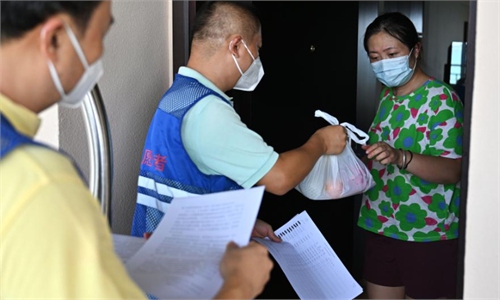NW China's Xinjiang reports 274 COVID-19 cases in a week; imported variant triggers flare-up

The nucleic acid testing in a lab Source: VCG
The virus in the current COVID-19 outbreak in Northwest China's Xinjiang Uygur Autonomous Region belongs to the evolutionary branch of Omicron sub-variant BA.5.2 that was initially imported from overseas, local health authorities said on Monday, noting that the current epidemic prevention and control situation in Xinjiang region remains complex and grim.
A total of 274 cases have been reported in Xinjiang region, affecting 12 counties and urban districts in seven prefectures and cities.
Xinjiang region reported no new confirmed cases and 69 new asymptomatic infections on Sunday, 59 of which were found in Yining, Ili Kazak Autonomous Prefecture. There are currently no confirmed cases in the region, but there are still 274 asymptomatic infections, of which 219 have been reported in Yining since July 30.
Officials from the local health authority said at the press conference on Monday that Xinjiang region has been hit by multiple sporadic clusters of COVID-19 infections, and the current epidemic prevention and control situation is still grim.
According to the comparison and analysis of virus genome sequences collected by the local center for disease control and prevention, it was found that the virus was of a different origin from the Omicron sub-variant BA.5.2 in the domestic coronavirus gene sequence database, so it can be concluded that the virus was imported from abroad.
In addition, Xinjiang region is currently at the peak of its tourist season, and gatherings of people and cross-regional movement may have potentially increased the transmission of the virus and the risk of its spread inside and outside Xinjiang.
Xinjiang has seen a surge in tourist numbers this summer, according to data from the Xinjiang Uygur Autonomous Region's Department of Culture and Tourism, which showed that Xinjiang received about 25.54 million tourists from July 1 to 21, up 15.7 percent year on year, with tourism revenues reaching about 19.1 billion yuan ($2.8 billion), a year-on-year increase of 16.67 percent.
Since the current outbreak of the epidemic, the region has received 8.82 million tourists from July 30 to August 7, and measures will be taken to protect their rights and interests, according to local authorities.
At present, the cultural and tourism market in Xinjiang region is stable and controllable, local authorities said, noting that local governments in the region have set up special tourism service teams to ensure timely responses to tourists' demands, and tourists who cancel hotel and ticket bookings due to the epidemic will be fully and unconditionally refunded.
Except for medium and high-risk areas in Xinjiang region, railways, highways and civil aviation are operating normally, ensuring the smooth flow of tourists and logistics. Local governments are actively guiding tourists from outside the region to leave in an orderly manner, and have provided water, food and other basic necessities at key checkpoints.
Xinjiang region has sent working groups to different regions in a bid to control and eliminate the risk of the epidemic as soon as possible through mass nucleic acid testing, epidemiological surveys and strict environmental disinfection and monitoring.
Global Times



